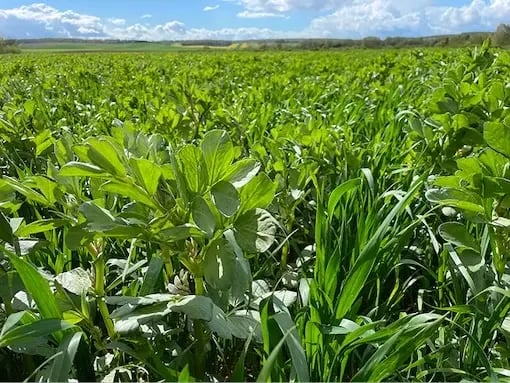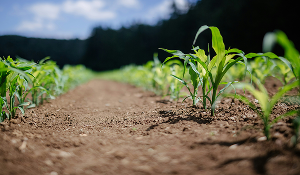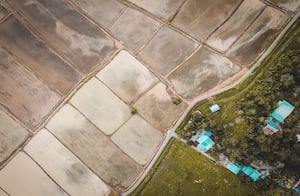Agriculture and Climate Change: Problem-to-Solution Approach: Case Study with Soil Capital
Table of Contents
1. The agricultural sector under scrutiny: farmers on trial for emissions
2. Farmers: the first victims of climate change
3. The agricultural sector: at the heart of a current challenge to feed tomorrow's world
4. Regenerative agriculture: one of the solutions to climate change?
5. The agricultural sector and the farmers crought cack to the center: The case of soil capital
Long considered a model for feeding a growing population, intensive agriculture is now being called into question. Accused of being one of the main sources of pollution and greenhouse gas emissions, it lies at the heart of environmental debates.
Yet, farmers are also its first victims, bearing the full brunt of climate change and economic pressure. In response to these challenges, a new model is emerging: land management projects such as regenerative agriculture. More than just an alternative, it offers an opportunity to restore soils, preserve biodiversity, and make the sector more resilient. But is this transition truly viable on a large scale?
The agricultural sector under scrutiny: farmers on trial for emissions
Agriculture, responsible for 25% of global greenhouse gas (GHG) emissions, is currently the second most polluting sector. This is a consequence of the legacy of a post-war productivity-driven model aimed at feeding populations weakened by the war, particularly by reintroducing proteins influenced by the American regime. With the implementation of the Marshall Plan, farmers were equipped with high-performance machines, fertilizers, and pesticides, used throughout the “30 Glorieuses” to increase agricultural yields massively and establish the foundations of the Révolution Verte.
Between 1950 and 2000, global cereal yields increased by 150% due to mechanization and intensification of agricultural practices. In 1950, global fertilizer consumption was 7 million tonnes; by 2020, it exceeded 200 million tonnes.
This model's development has led to dysfunctions that make it obsolete, calling into question its sustainability. Carbon impact continues to rise, with greenhouse gas emissions from food systems increasing by 10% between 2000 and 2021, nearly half of which come from farms. Biodiversity is greatly affected, with 80% of terrestrial species threatened by agricultural practices (land specialization, destruction of hedges and ponds, soil imbalance), and forests are under threat, with 80% of global deforestation linked to agriculture, particularly for agricultural expansion and the cultivation of products like soy, cocoa, and palm oil. In mainland France, agricultural land use covers approximately 26.7 million hectares, nearly half of the national territory. These practices also result in significant pollution and public health issues, as regularly highlighted by alerts, while contributing to food waste at all stages of the supply chain, from production to consumption.
Thus, the agri-food sector remains one of the main drivers of current environmental and societal crises, requiring a profound revision of its practices to meet sustainability challenges. For more information on regenerative agriculture, read our blog.
 Photo by Soil Capital
Photo by Soil Capital
Farmers: the first victims of climate change
As a contributor to climate change, agriculture is also its primary victim. For every degree of global warming, yields from major crops (wheat, rice, corn, soy) could decrease by 5 to 10%, while demand continues to rise. The year 2024 saw major climate disasters affecting both French and global agriculture, with a 22% decrease in cereal production in France compared to the previous five years. The challenges are numerous, and farmers, often under fire, are being blamed for a situation they are suffering from. In 1950, about 70% of the global population worked in agriculture, but by 2020, that proportion had fallen to around 30%.
By 2021, approximately 873 million people, or 27% of the global workforce, will be employed in agriculture, compared to 1.027 billion (40%) in 2000.
For more information on how regenerative agriculture generates avoidance and removal credits, read our blog.
The agricultural sector: at the heart of a current challenge to feed tomorrow's world
According to the United Nations (2023), the global population is estimated to reach 8.1 billion in 2025 and is expected to grow to 9.7 billion by 2050 and 10.4 billion by 2100. This demographic growth will drive a 60-70% increase in food demand by 2050, largely due to changing diets, with a higher consumption of meat and processed foods, especially in emerging countries.
Currently, 37% of the world’s land area is used for agriculture, with 77% dedicated to livestock (pastures and forage crops). However, arable land availability is declining, impacted by urbanization, soil erosion, and ecosystem degradation. While global food production is sufficient to feed 10 billion people, one-third of the food produced is lost or wasted each year, according to the FAO.
The carbon footprint of food products is significant, with around 80-90% of emissions coming from Scope 3 (indirect emissions), notably linked to animal proteins. Nearly a quarter of global water consumption is dedicated to producing food for livestock, while a significant portion of agricultural land is used to feed them. For example, the production of 1 kg of beef emits between 50 and 60 kg of CO₂, compared to 10 kg of CO₂ for most other food items.
Despite the ability to increase food supply, several barriers remain to restructuring the sector. The obsession with price often prevents making the right choices in terms of quality, quantity, and locality, contributing to value destruction. This dynamic makes it difficult to find sufficient margins to pay producers, while agriculture’s share in value creation in France has decreased, benefiting other sectors.
Additionally, the focus on cheap products illustrates a growing disconnect between humans and nature, reinforcing a detachment from what we consume. The current agricultural model is difficult to transform due to farmers' isolation, the profession's lack of appeal, high economic burdens, and limited prospects for generational renewal. While this profession is essential, it struggles to attract new vocations.
Solutions do exist to evolve toward more sustainable and less carbon-intensive agriculture, but implementing these solutions remains complex due to the many systemic challenges.
%201.png?width=934&height=623&name=Francis%20pestre%20(agri%20du%20programme)%201.png) Photo by Soil Capital
Photo by Soil Capital
Regenerative agriculture: one of the solutions to climate change?
Agriculture is heavily impacted by the effects of climate change and represents a key lever to implement solutions to combat it. Among these solutions, the adoption of regenerative agriculture practices by a growing number of farmers is a promising response.
Soil fertility and climatic ecosystems are under serious threat. Around 80% of farmers are concerned about the viability of their soils, but innovation in farming practices remains risky and costly. Nevertheless, healthy soil is key to restoring ecosystems and ensuring farm resilience.
Regenerative agriculture relies on practices designed to restore soil fertility while maintaining productivity. These practices include:
-
Organic fertilization:
This method reduces fossil fuel use for fertilizer production and improves CO2 capture in soils. Limiting or eliminating the use of pesticides, herbicides, and chemical fertilizers, protects sensitive species, such as pollinators, birds, and small mammals. It also promotes the return of endangered or declining species, contributing to ecosystem resilience. -
Vegetative cover:
By capturing nitrogen from the atmosphere and improving nutrient circulation, it enhances soil fertility while protecting its structure and reducing erosion. -
Crop rotation and diversification, along with agroforestry:
These practices restore biodiversity while reducing chemical input use. Agroforestry and planting hedges around fields provide refuge for birds, insects, and mammals. Additionally, maintaining wetlands and grassy strips increases habitat diversity, attracting a wide range of species. -
Return to natural cycles:
Allowing parts of land to rest or practicing diverse crop rotations promotes natural resource regeneration and supports long-term biodiversity.
Soils restored by these practices encourage a living soil rich in microorganisms, insects, and fungi. These play a critical role in nutrient cycles and overall ecosystem health, contributing to better soil fertility. Thus, the soil stores more carbon but also allows for better water absorption, mitigating the impacts of droughts and floods. Healthier soil also improves the nutritional quality of crops and restores biodiversity, which is essential for ecosystems.
However, these practices can only succeed if farmers are central to the solutions. Transition support policies must help farmers innovate and reduce financial barriers to ensure a sustainable future for agriculture.

Photo by Soil Capital
The agricultural sector and the farmers brought back to the center: the case of soil capital
Soil Capital is the first certified European carbon payment program designed to accelerate the transition to regenerative agriculture. Founded in 2013, the company launched its program in 2019 and currently supports over 1,600 farmers across France, the UK, and Belgium, covering approximately 350,000 hectares.
With an approach based on agronomic exchanges, Soil Capital rewards farmers through the generation and sale of carbon certificates while going beyond carbon impact. The environmental benefits include soil health, water quality, biodiversity protection, and farmers' socio-economic well-being. Soil Capital enables local action, strengthening supply chains with measurable results validated by independent audits each year.
The program supports farmers in their efforts in favor of the environment and the risks they take in modifying their practices, benefiting society as a whole. Soil Capital redistributes 70% of the revenue from sold carbon certificates as regular payments to farmers.
The impact of this model is significant: Over 10 million euros have already been redistributed, and the program is generating growing interest, attracting an increasing number of farmers willing to take this approach.
 Photo by Soil Capital
Photo by Soil Capital
If you need more information to invest in credible carbon projects, contact us.
Sources: FAO / Agreste Agriculture / Le Monde / FAO Newsroom / LSA / GEO / Insee
Common Q&As
Regenerative agriculture projects go much beyond carbon and can positively affect what daily impacts every human being on earth, i.e., food.
For more information refer to our article: Embracing Regenerative Agriculture.
The three main pillars include; reduction of soil disturbances (tilling/non-till farming), optimally using cover crops, and reducing or eliminating pesticides/synthetic fertilizers.
For more information refer to our article: Embracing Regenerative Agriculture.
Regenerative agriculture projects (classified under Nature-based Solutions) have the unique potential to generate both avoidance and removal carbon credits, thanks to the multifaceted ways in which they interact with the carbon cycle.
For more information refer to our article:
Does Regenerative Agriculture Generate Avoidance or Removal Credits?.
Share this
You May Also Like
These Related Stories

Does Regenerative Agriculture Generate Carbon Avoidance or Removal Credits?
.jpg?width=4928&height=3264&name=sun-shining-in-rain-drops-alt-sunset-in-nature-2022-02-02-03-49-48-utc%20(1).jpg)
Embracing Regenerative Agriculture, why is it crucial?


